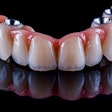Even the tooth fairy is not immune to the lingering economic challenges, leaving an average of $2.60 per tooth in 2011 -- 40% less than last year's $3 per tooth, according to a survey by Visa.
The survey of 1,006 U.S. adults, conducted July 12 in cooperation with GfK Roper OmniTel, suggests 90% of U.S. children younger than 12 receive money from the tooth fairy, down from 94% in 2010.
When broken down by regions across the U.S., the survey results show that significant changes have taken place in how much money the tooth fairy leaves:
- In the Eastern U.S., the tooth fairy now leaves $2.10, a 38% cut from the $3.40 left in 2010.
- Southern states also saw a significant decrease in the tooth fairy's largess, $2.60 in 2011 versus $3.30 in 2010 -- a 21% reduction.
- Midwestern children receive an average of $2.80, a modest 3% decrease from last year's $2.90.
- The West bucked the national trend of a belt-tightening tooth fairy, with children pocketing $2.80, up 4% from last year's $2.70.
Additional survey findings included the following:
- 10% of children receive no money from the tooth fairy; according to last year's survey, only 6% of children did not receive money from the tooth fairy.
- 7% of children receive less than a dollar.
- 29% of children receive exactly $1; last year's survey showed that 37% of children received exactly $1.
- 18% of children receive $2 to $4.
- 18% of children receive $5, compared with 22% last year.















